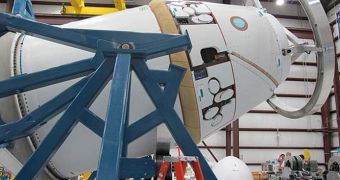One of the first private space capsules to be developed in the United States has been programmed to launch in early November, announce representatives of its manufacturer.
The Dragon spacecraft will blast off atop a Falcon 9 delivery system. Both instruments are being developed by Hawthorne, California-based company Space Exploration Technologies.
SpaceX conducts the development process under a Commercial Orbital Transportation Services (COTS) program agreement it signed with the American space agency.
The ultimate goal of the program is the construction of a space capsule that can ferry cargo, and eventually astronauts, to the International Space Station (ISS) and low-Earth orbit (LEO).
At this point, the main COTS contracts are between NASA and SpaceX, on one side, and NASA and Orbital Sciences Corporations, on the other side. Orbital is developing the Cygnus spacecraft.
Though SpaceX should have carried out the newly-planned November test flight several months ago, various glitches and delays have postponed the launch date several times.
The situation was made worse by the fact that even the rocket which needs to carry the Dragon to orbit is new. The first successful flight of the Falcon 9 took place this June.
According to officials at SpaceX, the November test flight will seek to insert that launch system in precisely the same trajectory that the rocket took during its maiden flight.
Take-off will take place from the Cape Canaveral Air Force Station (CCAFS), in Florida, a facility that is located right next door to the Kennedy Space Center (KSC), the home of the US shuttle fleet.
During the new flight, the main goal is to see if Dragon can complete at least four orbits around the planet before reentering the atmosphere.
When in LEO, the spacecraft will receive numerous commands from the ground, which are meant to assess the operations status of most of its onboard systems, Space reports.
Upon reentry, the capsule needs to withstand the tremendous heat generated by air friction, and then make a safe water landing, guided by parachutes.
“For this first demo flight, Dragon will make multiple orbits of the Earth as we test all of its systems, and will then fire its thrusters to begin reentry, returning to Earth for a Pacific Ocean splashdown off the coast of Southern California,” explains SpaceX CEO Elon Musk.
“The entire mission should last around four hours,” he goes on to say. If successful, the flight will ensure a continuation of the $1.6 billion contract SpaceX has with NASA.

 14 DAY TRIAL //
14 DAY TRIAL //